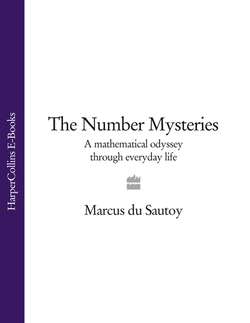Читать книгу The Number Mysteries: A Mathematical Odyssey through Everyday Life - Marcus Sautoy du - Страница 29
Why are bubbles spherical?
ОглавлениеTake a piece of wire and bend it into a square. Dip it in bubble mixture and blow. Why isn’t it a cube-shaped bubble that comes out the other side? Or if the wire is triangular, why can’t you blow a pyramid-shaped bubble? Why is it that, regardless of the shape of the frame, the bubble comes out as a perfect spherical ball? The answer is that nature is lazy, and the sphere is nature’s easiest shape. The bubble tries to find the shape that uses the least amount of energy, and that energy is proportional to the surface area. The bubble contains a fixed volume of air, and that volume does not change if the shape changes. The sphere is the shape that has the smallest surface area which can contain that fixed amount of air. That makes it the shape that uses the least amount of energy.
Manufacturers have long been keen to copy nature’s ability to make perfect spheres. If you’re making ball bearings or shot for guns, getting perfect spheres could be a matter of life and death, since a slight imperfection in the spherical shape could lead to a gun backfiring or a machine breaking down. The breakthrough came in 1783 when a Bristol-born plumber, William Watts, realized that he could exploit nature’s predilection for spheres.
When molten iron is dropped from the top of a tall tower, like the bubble the liquid droplets form into perfect spheres during their descent. Watts wondered whether, if you stuck a vat of water at the bottom of the tower, you could freeze the spherical shapes as the droplets of iron hit the water. He decided to try his idea out in his own house in Bristol. The trouble was that he needed the drop to be further than three floors to give the falling molten lead time to form into spherical droplets.
So Watts added another three storeys on top of his house and cut holes in all the floors to allow the lead to fall through the building. The neighbours were a bit shocked by the sudden appearance of this tower on the top of his home, despite his attempts to give it a Gothic twist with the addition of some castlelike trim around the top. But so successful were Watts’s experiments that similar towers soon shot up across England and America. His own shot tower stayed in operation until 1968.
Although nature uses the sphere so often, how can we be sure that there isn’t some other strange shape that might be even more efficient than the sphere? It was the great Greek mathematician Archimedes who first proposed that the sphere was indeed the shape with the smallest surface area containing a fixed volume. To try to prove this, Archimedes began by producing formulas for calculating the surface area of a sphere and volume enclosed by it.
FIGURE 2.01 William Watts’s clever use of nature to make spherical ball bearings.
Calculating the volume of a curved shape was a significant challenge, but he applied a cunning trick: slice the sphere with parallel cuts into many thin layers, and then approximate the layers by discs. Now, he knew the formula for the volume of a disc: it was just the area of the circle times the thickness of the disc. By adding together the volumes of all these different sized discs, Archimedes could get an approximation for the volume of the sphere.
FIGURE 2.02 A sphere can be approximated by stacking different sized discs on top of one another.
Then came the clever bit. If he made the discs thinner and thinner until they were infinitesimally thin, the formula would give an exact calculation of the volume. It was one of the first times that the idea of infinity was used in mathematics, and a similar technique would eventually become the basis for the mathematics of the calculus developed by Isaac Newton and Gottfried Leibniz nearly two thousand years later.
Archimedes went on to use this method to calculate the volumes of many different shapes. He was especially proud of the discovery that if you put a spherical ball inside a cylindrical tube of the same height, then the volume of the air in the tube is precisely half the volume of the ball. He was so excited by this that he insisted a cylinder and a sphere should be carved on his gravestone.
Although Archimedes had successfully found a method to calculate the volume and surface area of the sphere, he didn’t have the skills to prove his hunch that it is the most efficient shape in nature. Amazingly, it was not until 1884 that the mathematics became sophisticated enough for the German Hermann Schwarz to prove that there is no mysterious shape with less energy that could trump the sphere.
